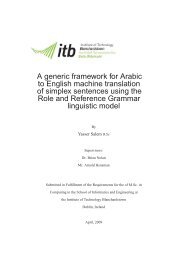On the occurrence and consequences of inaccurate ... - Acsu Buffalo
On the occurrence and consequences of inaccurate ... - Acsu Buffalo
On the occurrence and consequences of inaccurate ... - Acsu Buffalo
Create successful ePaper yourself
Turn your PDF publications into a flip-book with our unique Google optimized e-Paper software.
E.R. Odders-White / Journal <strong>of</strong> Financial Markets 3 (2000) 259}286 277<br />
4.2. Consequences <strong>of</strong> misclassixcation<br />
The preceding section contains detailed descriptions <strong>of</strong> <strong>the</strong> types <strong>of</strong> transactions<br />
for which <strong>the</strong> Lee <strong>and</strong> Ready method fails. Such an analysis seems<br />
unnecessary, however, if misclassi"cation has no e!ect on <strong>the</strong> results <strong>of</strong> economic<br />
research. This section provides two applications in which misclassi"ed<br />
transactions lead to biased results.<br />
4.2.1. Investor behavior surrounding earnings announcements<br />
The "rst example is Lee's (1992) study <strong>of</strong> investor behavior surrounding<br />
earnings announcements. Lee used event-study methodology to examine <strong>the</strong><br />
intraday trading activity <strong>of</strong> large <strong>and</strong> small traders around both good <strong>and</strong> bad<br />
earnings announcements. As expected, he found that good earnings announcements<br />
were associated with periods <strong>of</strong> increased buying regardless <strong>of</strong> trade size.<br />
He also documented a puzzling increase in <strong>the</strong> number <strong>of</strong> small purchases in<br />
response to bad earnings announcements, however. Although he considered<br />
several possible explanations, he was ultimately unable to explain this<br />
result.<br />
The analysis in Section 4.1 suggests that <strong>the</strong> more frequent misclassi"cation <strong>of</strong><br />
small seller-initiated transactions may be at least partially responsible for this<br />
anomaly. The intuition behind this explanation is as follows. First, <strong>the</strong> results in<br />
Table 3 demonstrate a greater incidence <strong>of</strong> misclassi"cation for transactions<br />
occurring inside <strong>the</strong> spread. Second, we would expect small trades to occur<br />
inside <strong>the</strong> spread more <strong>of</strong>ten since smaller transactions tend to receive price<br />
improvement more <strong>of</strong>ten than large transactions. The results in Table 4 con"rm<br />
this hypo<strong>the</strong>sis. In addition, Petersen <strong>and</strong> Fialkowski found that sell orders<br />
received greater price improvement than buy orders. As a result, small sell<br />
transactions are likely to be misclassi"ed (as buys) more <strong>of</strong>ten than o<strong>the</strong>r types <strong>of</strong><br />
transactions.<br />
In Appendix A, I provide two pieces <strong>of</strong> evidence in support <strong>of</strong> this hypo<strong>the</strong>sis.<br />
First, I partition <strong>the</strong> data into large trades <strong>and</strong> small trades using Lee's dollarbased<br />
measure <strong>of</strong> trade size (which di!ers slightly from that used in<br />
Table 4). The results in Table 5 illustrate that <strong>the</strong> Lee <strong>and</strong> Ready method <strong>and</strong> <strong>the</strong><br />
true classi"cation produce almost identical fractions <strong>of</strong> buys <strong>and</strong> sells for large<br />
transactions. <strong>On</strong> <strong>the</strong> o<strong>the</strong>r h<strong>and</strong>, for small transactions, <strong>the</strong> discrepancy between<br />
<strong>the</strong> Lee <strong>and</strong> Ready <strong>and</strong> <strong>the</strong> true classi"cationsisoverthreetimesaslarge,with<strong>the</strong><br />
Lee <strong>and</strong> Ready method classifying more trades as sells. While <strong>the</strong> di!erence is<br />
small in absolute terms, it is big relative to that for large trades <strong>and</strong> is statistically<br />
signi"cant at <strong>the</strong> 0.03% level. The frequency <strong>of</strong> misclassi"cation is<br />
likely to increase around earnings announcements due to an increase in trading,<br />
as well.<br />
Second, I replicate Lee's analysis to provide direct evidence that trade misclassi"cation<br />
is a partial explanation <strong>of</strong> <strong>the</strong> anomaly documented in his study.
















